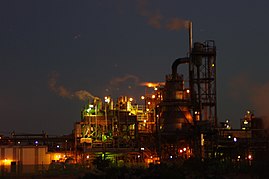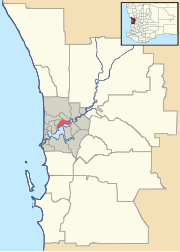Kwinana Beach, Western Australia
|
Kwinana Beach Perth, Western Australia |
|||||||||||||
|---|---|---|---|---|---|---|---|---|---|---|---|---|---|

A chemical plant in Kwinana Beach
|
|||||||||||||
| Coordinates | 32°14′49″S 115°45′32″E / 32.247°S 115.759°ECoordinates: 32°14′49″S 115°45′32″E / 32.247°S 115.759°E | ||||||||||||
| Postcode(s) | 6167 | ||||||||||||
| LGA(s) | City of Kwinana | ||||||||||||
| State electorate(s) | Kwinana | ||||||||||||
| Federal Division(s) | Brand | ||||||||||||
|
|||||||||||||
Kwinana Beach is an industrial suburb of Perth, Western Australia within the City of Kwinana.
Kwinana is originally a local indigenous Australian word meaning either "young woman" or "pretty maiden". The ship SS Kwinana was wrecked on Cockburn Sound in 1922, and blown on to the beach. The nearby area acquired the name Kwinana Beach when the local postmistress, Clara Wells, immediately started labeling the mail sacks "Kwinana Wreck", to distinguish the settlement there from Rockingham, to the south Kwinana Beach was officially adopted as a township in 1937.
With the new industrial developments at Kwinana Beach in the 1950s, led by BP's Kwinana Refinery, a large new workers settlement – Kwinana Townsite – was purpose-built slightly inland.
Other industries quickly followed – Alcoa, CSBP,CBH, Coogee Chemicals, and others.
The original village at Kwinana Beach was rezoned 'industrial', and scheduled for resumption and compulsory purchase as early as 1953 – apparently unbeknown to the residents. Confirmed in the Stephenson Plan (1955), this was ratified by State Parliament in the 1963 Perth Metropolitan Region Scheme. However, building applications were still being approved throughout the 1960s, and beyond – with a vague warning that the land was earmarked for "potential industrial development".
There was no real public comment until 1968, following increased pollution, nuisance, and health problems from the growing industrial development just north of the village. This led to a rather lively Council meeting at the Kwinana Beach Hall in September, 1969. The dangers of property resumption were played down by the Kwinana Mayor, Cr. F. Baker, who advised residents to stay put and see what happened. The Air Pollution consultant, Mr A. Keil, informed them that, though there were no immediate plans to use the land for industry, it was a definite possibility – and pollution problems were "unavoidable", and would only get worse. Residents responded that they didn't mind moving, so long as the compensation was fair, and enabled them to purchase a property of at least equal value – rather than leaving them in debt. Finally, a committee was formed to look into the issues.
Matters remained in limbo throughout the 1970s, with residents accepting resumption of their properties as conditions became increasingly intolerable.
...
Wikipedia

